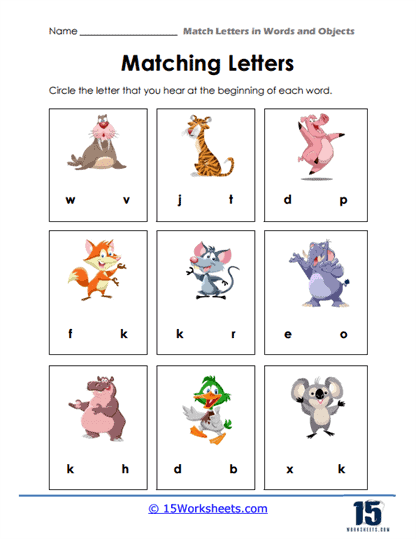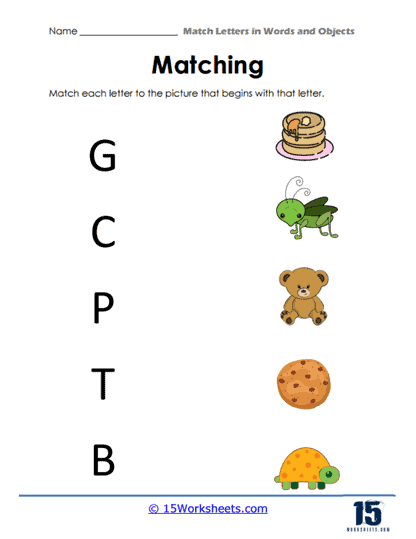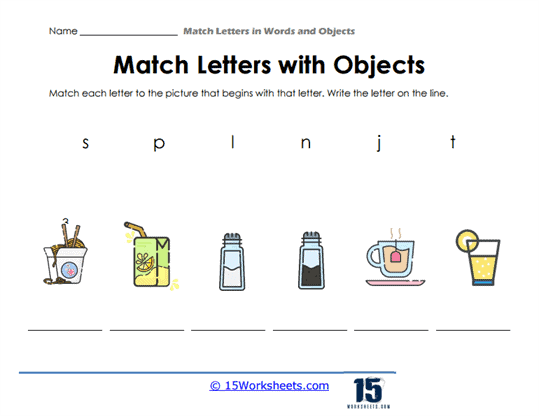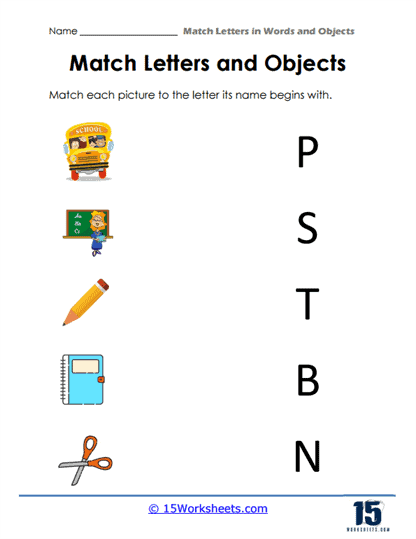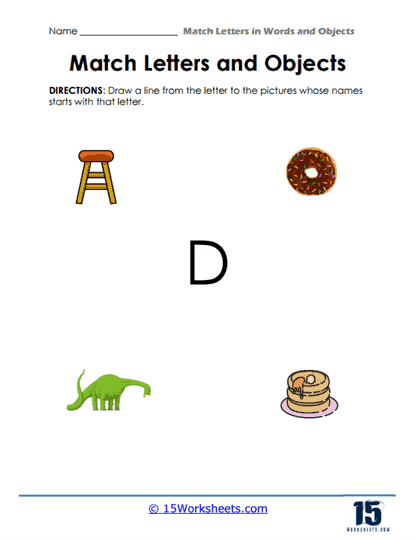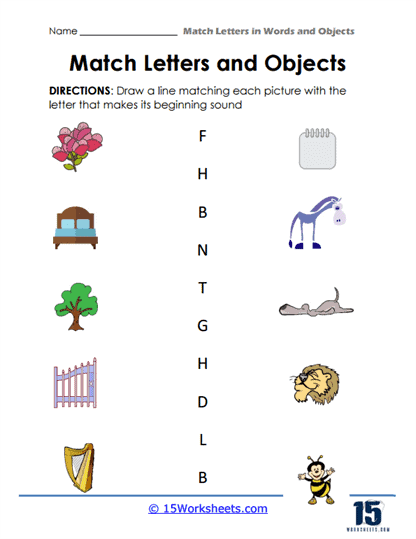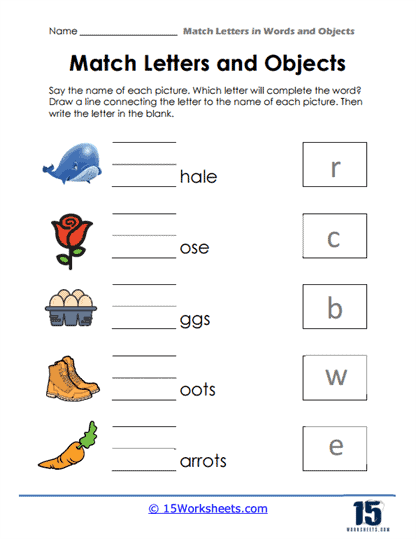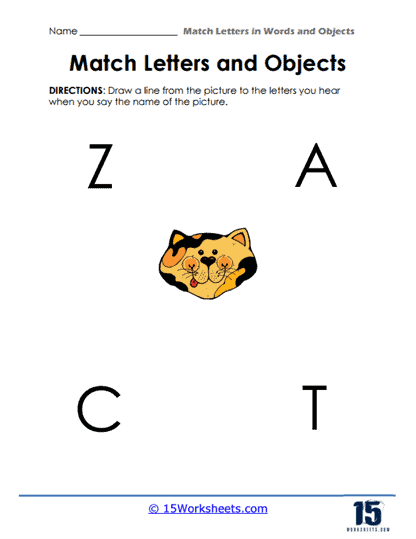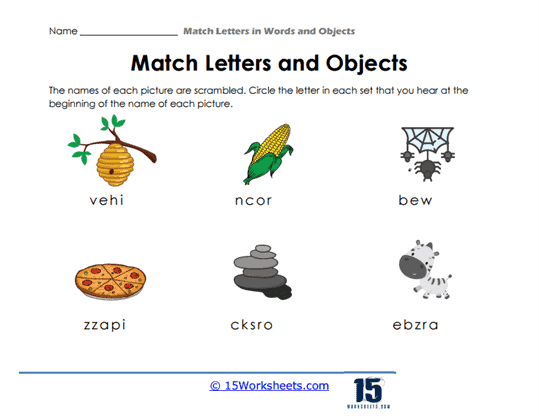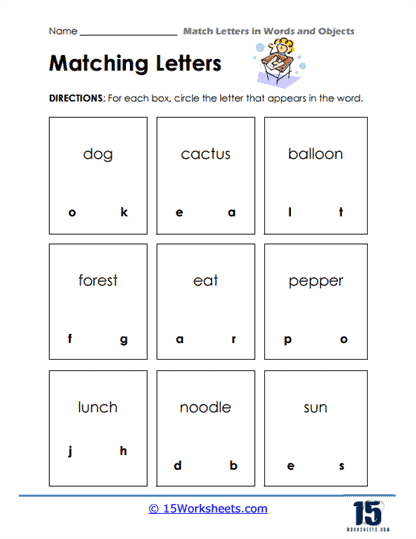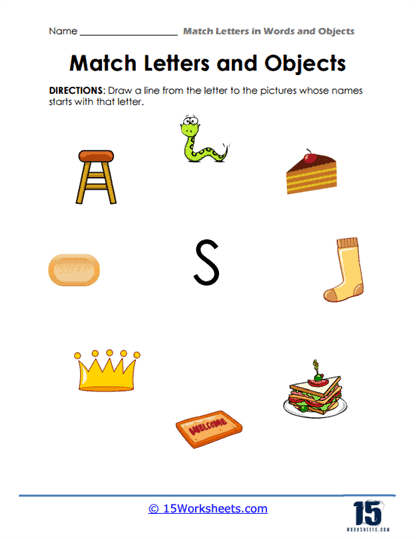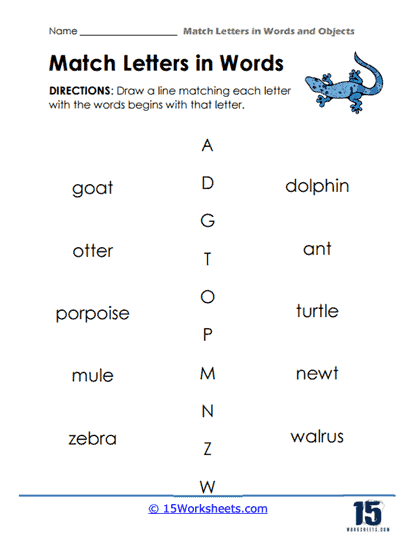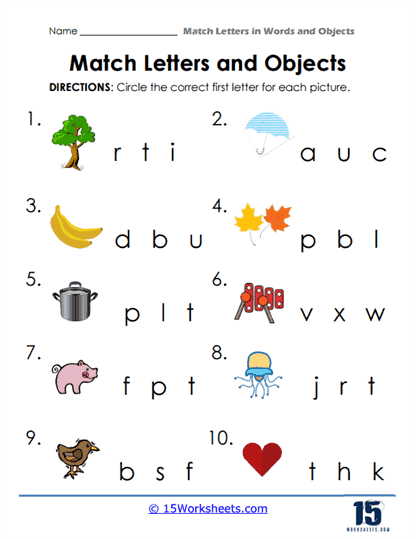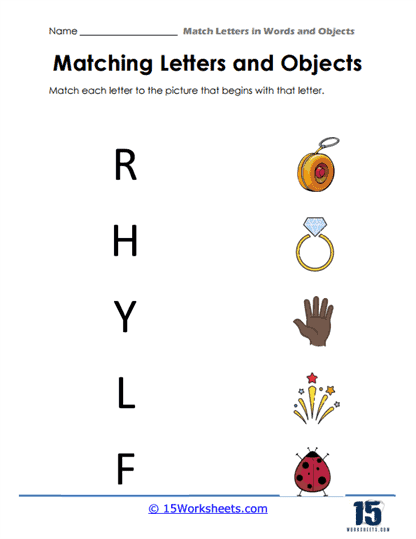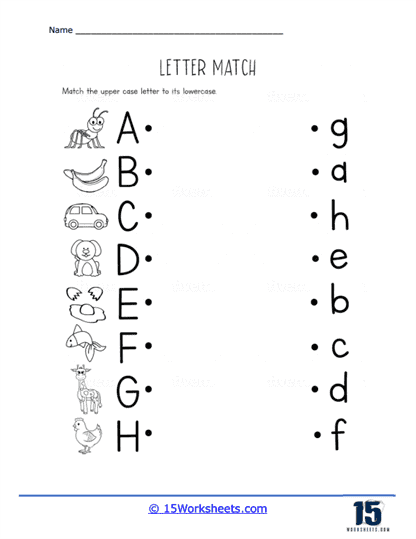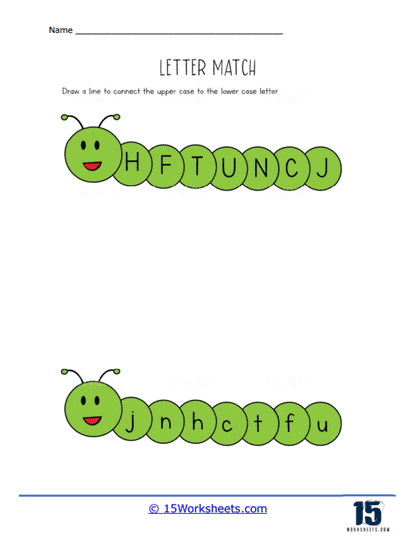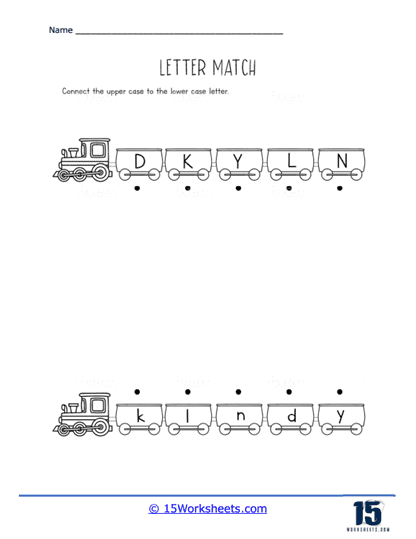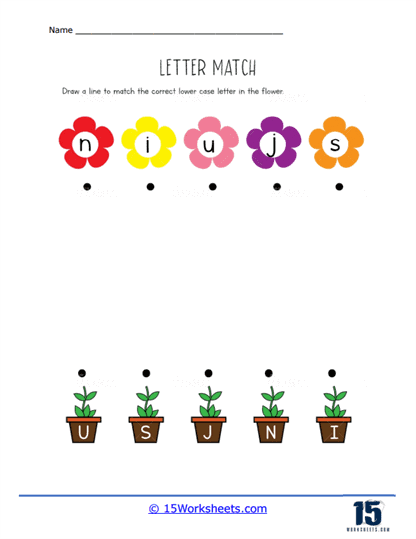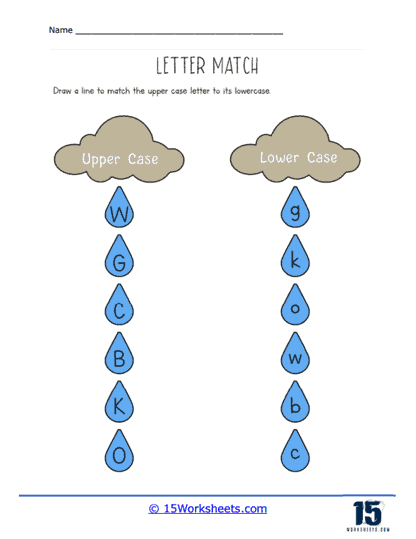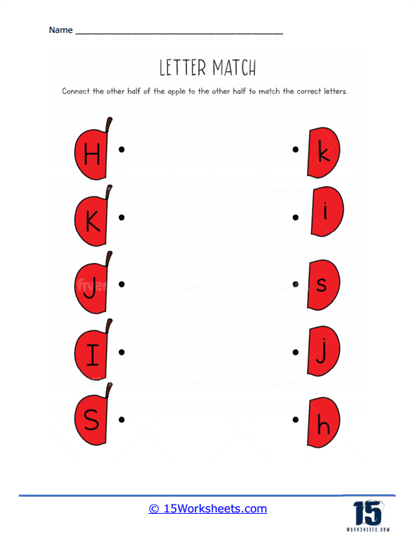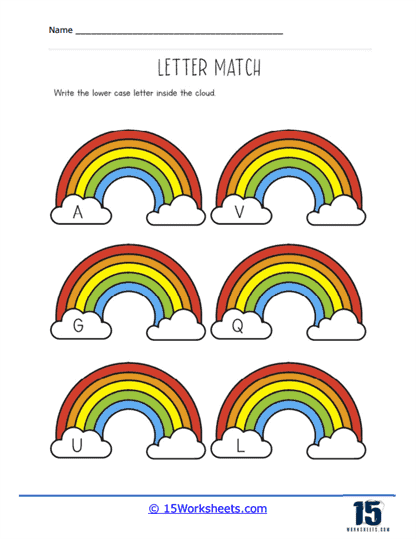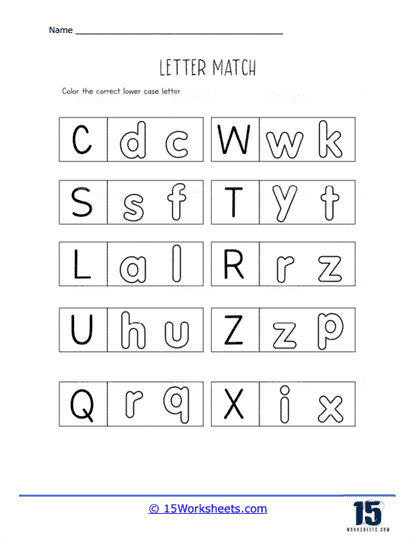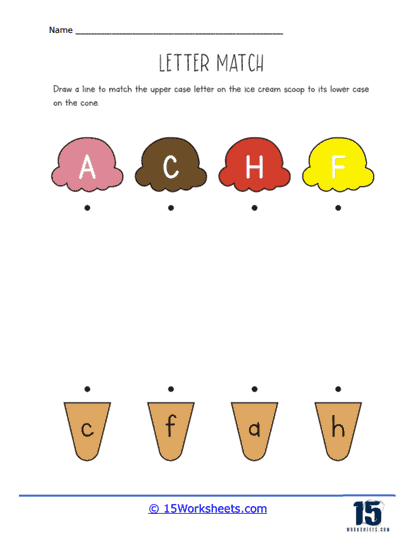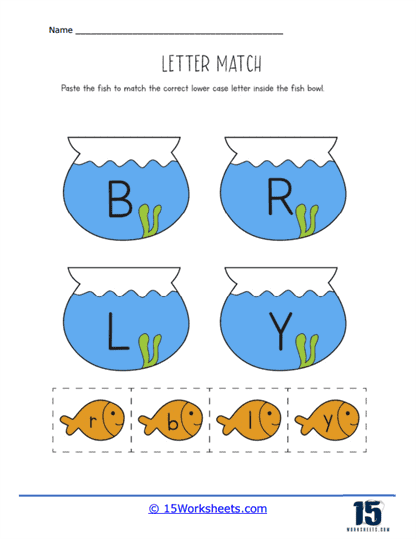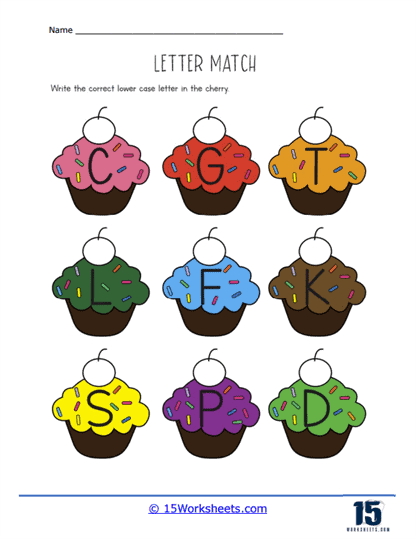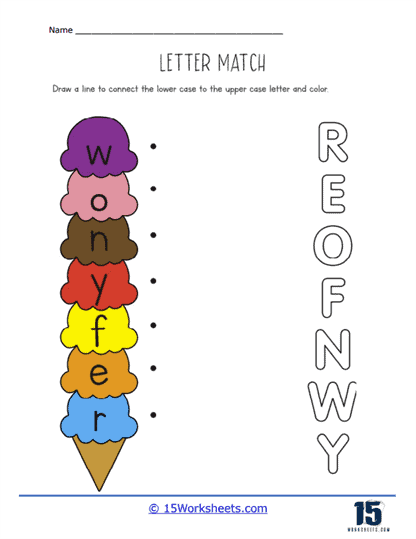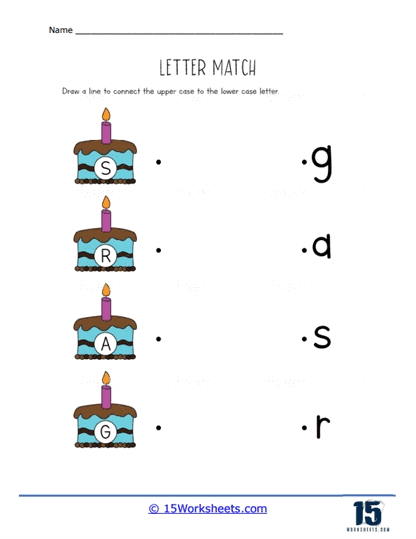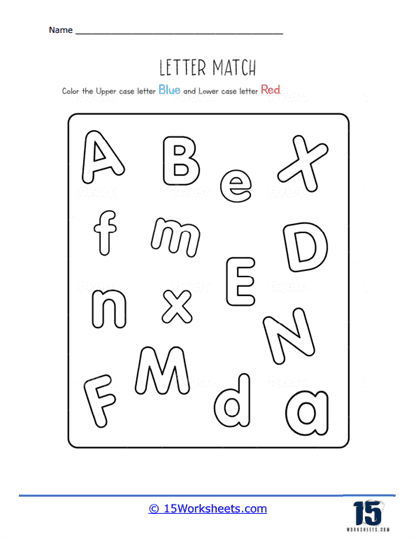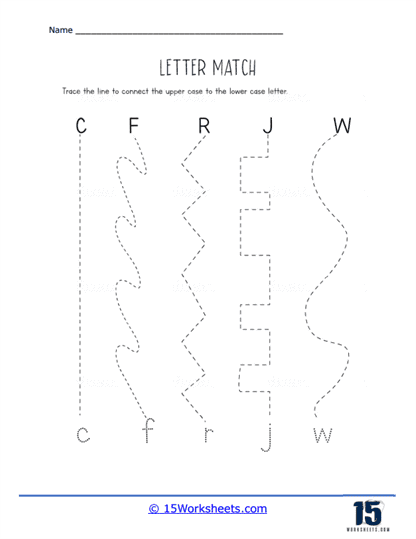Match Letters Worksheets
All About These 15 Worksheets
Learning the alphabet is one of the first major milestones in a child’s literacy development. It lays the foundation for all future reading and writing skills. But beyond just recognizing letters, understanding the relationship between uppercase and lowercase forms is equally critical. This is where Match Uppercase and Lowercase Letters Worksheets come into play-serving as a dynamic tool in early education. These worksheets are not just simple activities; they represent a crucial step in a child’s ability to decode written language and make sense of the letters that fill the books they will eventually read on their own.
At their core, these worksheets will help children match uppercase letters with their corresponding lowercase forms. Typically, they feature uppercase letters on one side and lowercase letters on the other, challenging young learners to connect the pairs. While this may seem like a basic task, it actually requires the development of several cognitive skills, such as visual discrimination, memory, and concentration. Furthermore, some worksheets go beyond basic matching, incorporating exercises that link letters to their sounds and showcasing how these letters are used in everyday words and objects. This holistic approach ensures that students not only learn to match letters but also understand their broader role in language.
For children just beginning their literacy journey, matching uppercase and lowercase letters is a vital step. This simple yet effective activity helps them understand that the same letter can take on different forms depending on where it appears in a word or sentence. Recognizing that ‘A’ and ‘a’ are the same letter, despite their visual differences, is an essential component of reading fluency. Mastering this concept aids in smoother reading as children begin to encounter both letter forms in books, signs, and everyday print material. Without this knowledge, children might struggle to decode words, leading to frustration and disengagement from reading altogether.
I, as an educator or parent, can play an instrumental role in facilitating this learning process by offering interactive and engaging methods for matching uppercase and lowercase letters. One highly effective approach is through hands-on exercises, where students actively match the letters themselves. These could be in the form of paper worksheets, which require students to draw lines between matching pairs, or digital platforms that allow them to click and drag letters to their counterparts. This tactile engagement not only reinforces their visual recognition of the letters but also helps solidify the concept in their memory through repetitive practice.
Another tool in the arsenal is the use of virtual flashcards. Imagine a digital flashcard where the child sees a lowercase ‘b’ on one side, and with a simple click or swipe, the uppercase ‘B’ is revealed. The interactive nature of this activity makes it more engaging than traditional flashcards and encourages independent learning. Children can practice at their own pace, repeating cards they find challenging, until they become confident in their ability to match the letters. These virtual resources also offer the advantage of instant feedback, ensuring that mistakes can be corrected immediately, which is crucial for effective learning.
The learning process can be elevated through the incorporation of letter recognition games. Games bring an element of fun and excitement to the task, transforming what could be a mundane exercise into an enjoyable challenge. For example, students could participate in a race to see who can match the most letter pairs correctly, or they could play memory games where they flip over cards to reveal uppercase and lowercase letters, attempting to find the matching pairs. The competitive aspect of these games, whether against peers or against their own previous scores, can be highly motivating for young learners, driving them to engage with the material repeatedly.
To accommodate different learning levels and needs, educators and parents can develop customized worksheets. These worksheets can vary in complexity-some might feature a limited number of letter pairs for beginners, while others might include a mix of easily recognizable and more challenging letters for more advanced students. By tailoring the difficulty of these worksheets, we ensure that every child is working at a level that is appropriate for them, allowing for both steady progress and a sense of accomplishment as they improve. Personalized worksheets also enable educators to focus on particular letters that a student might be struggling with, providing targeted practice that can help close any learning gaps.
It’s important to recognize that letter matching activities serve a dual purpose. Beyond letter recognition, they help children develop fine motor skills. Whether it’s drawing lines to connect letters on a worksheet or physically flipping flashcards, these activities require the kind of precision and control that helps children with other tasks like handwriting. So while these worksheets focus primarily on literacy skills, they also contribute to a child’s overall development in ways that extend beyond reading.
Types of Exercises
This series of worksheets comes in a variety of creative and engaging formats, each designed to support a child’s literacy development in different ways. These worksheets are not just simple exercises; they are essential building blocks that help children form a strong foundation in reading, writing, and overall language comprehension. By offering various formats that cater to different learning styles, these activities ensure that every child can find a method that resonates with them, making the learning process more effective and enjoyable.
Matching Letters
One of the most common formats of these worksheets is the straightforward matching of uppercase and lowercase letters. In this activity, children are presented with a mix of uppercase and lowercase letters, typically in two columns or rows. The task is for the child to draw a line from an uppercase letter, such as “A,” to its corresponding lowercase letter, “a.” While this may seem like a basic exercise, it plays a crucial role in helping children visually distinguish between the two forms of the same letter. It requires attention to detail, as children must carefully examine each letter’s features to make the correct match. This activity reinforces the concept that letters, despite their varying appearances, represent the same sounds and are used interchangeably in different contexts.
Letter-to-Word Matching
Another engaging variation is the letter-to-word matching worksheet. In this format, children are given a list of uppercase letters on one side, such as “B,” “A,” and “D,” and on the other side, they see a list of simple words like “Dog,” “Bat,” and “Apple.” The child’s task is to draw a line connecting each letter to the word that begins with that letter. This type of worksheet introduces an added layer of complexity, as children must not only recognize the letter but also recall the corresponding sound and identify which word begins with that sound. This exercise helps build phonemic awareness, a crucial skill for reading, as children learn to associate letters with their sounds and sounds with words. It also provides an early introduction to decoding, which is the ability to translate printed words into sounds-a fundamental skill in reading.
Object Matching
Some children learn best through visual stimuli, which is where object matching worksheets come into play. In this type of worksheet, children are presented with a list of uppercase or lowercase letters alongside pictures of familiar objects. For example, they might see the letter “B” next to an image of a ball, or “A” next to an apple. The task is to match the letter to the object that starts with that sound. This format adds an element of fun and creativity to letter recognition, as children get to visually connect letters with real-world objects. By linking abstract letters to tangible things they encounter in their everyday lives, children deepen their understanding of how letters form the building blocks of words and meaning. This activity also strengthens vocabulary, as they are exposed to new words through the pictures.
Memory Games
A more interactive and playful approach to learning uppercase and lowercase letters is through memory games. In this activity, children are provided with cards that have uppercase letters on one side and lowercase letters on the other. The cards are shuffled and laid face down. The child’s task is to flip two cards at a time, trying to find a matching pair-one uppercase and one lowercase letter. Memory games like this are excellent for developing both letter recognition and memory skills. They require children to remember the location of specific letters and recall them later in the game. This exercise also promotes cognitive development, as it requires concentration, patience, and strategic thinking to successfully match pairs. It turns learning into a fun, competitive activity that children often enjoy repeating, thereby reinforcing their skills through repetition.
Cut and Paste Activities
For children who benefit from hands-on learning, cut-and-paste activities can be particularly effective. In these worksheets, children are given a set of uppercase and lowercase letters that they must cut out and then paste next to their corresponding pair. This type of activity combines literacy learning with fine motor skill development, as the cutting and pasting require precise hand movements and coordination. By physically manipulating the letters, children are able to engage with the learning process in a tactile way, which can help reinforce their understanding. The act of matching letters through cutting and pasting also adds a layer of creativity, making the activity feel more like an art project than a traditional worksheet.
Writing Exercises
Another essential format for letter recognition worksheets involves writing exercises. These worksheets ask children to write uppercase and lowercase letters next to each other, often repeatedly, to practice the formation of both cases. Writing out the letters by hand is a powerful tool in helping children internalize the shape and structure of each letter. This activity not only aids in letter recognition but also improves a child’s handwriting skills. The more children practice writing both forms of the letters, the more fluent they become in identifying and using them in reading and writing tasks. Writing exercises also help develop muscle memory, making it easier for children to write both uppercase and lowercase letters automatically in the future.
The variety of worksheets described above offers numerous benefits for children as they begin their literacy journey. Letter recognition is one of the primary skills these worksheets aim to develop. By learning to recognize and match uppercase and lowercase letters, children are better prepared to decode words when they encounter them in reading. Understanding letter case is another crucial benefit. Children must learn the distinction between uppercase and lowercase letters, as this knowledge is essential for proper sentence structure and grammar in writing. These worksheets give children the opportunity to practice this skill in a structured, repetitive way that solidifies their understanding.
Why Is This Skill Important?
Understanding the importance of matching lowercase and uppercase letters is crucial for motivating students to learn this skill. I can offer guidance and explanations that highlight the significance of letter case in reading and writing. This comprehension reinforces the relevance of letter matching in their literacy journey, encouraging active engagement in the learning process.
Matching lowercase and uppercase letters holds significant importance in literacy for several reasons. It directly impacts reading skills by enabling students to recognize letter cases within words, thus enhancing reading comprehension. Furthermore, as students begin to write, the ability to distinguish between lowercase and uppercase letters becomes essential for proper sentence and paragraph structure. This skill also contributes to text legibility, as consistent use of letter case ensures readability. Additionally, understanding letter case is intricately linked to proper grammar and punctuation usage, such as capitalizing the beginning of sentences and proper nouns. Finally, in today’s digital age, effective communication through written text relies heavily on the correct use of uppercase and lowercase letters in emails, messages, and documents.

